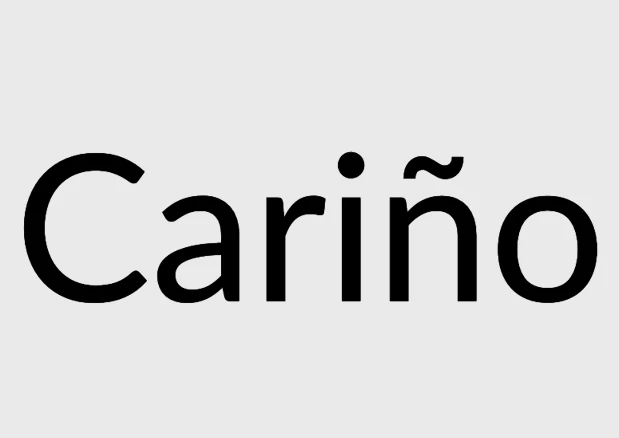Depending on the context, the word cariño has several meanings. It can be translated as “care”, “love” or “affection”. In general, Spanish speakers use it to express fondness or endearment towards someone. They also use it as a loving nickname to state they are close to a specific person.
In this article, we will show you how to identify what this term means exactly in every case. Additionally, with the help of our audio examples, we will teach you how to use it properly.
What Does Cariño Mean in Spanish?
According to the Royal Spanish Academy (RAE), cariño is a noun that refers to the inclination of love or affection felt towards someone or something.
It is used to describe feelings of warmth or kindness that a person has for a friend, a family member, a significant other, a child, or even a pet.
Based on the circumstances, it can convey sentiments of tenderness, love, or a positive feeling. There is no direct translation into English. The context of the conversation will determine the best possible interpretation.
How to Use Cariño
As said, cariño is a term associated with affection. In this section, we’ll explore the different ways you can use the word in everyday conversations with your Spanish-speaking loved ones.
1. As a Feeling
Although cariño is not as strong as amor, it is a noun that refers to a feeling of affection and fondness towards someone you are close to. You can use it to talk about any person or thing you are fond of.
- Cuando salgo al escenario puedo sentir el cariño de la gente. / When I go on stage I can feel people’s affection.
- Le regalé una caja de chocolates como muestra de mi cariño. / I gave her a box of chocolates as a token of my affection.
- No quiero vender el auto, ¡ya le tengo cariño! / I don’t want to sell the car, I’m so fond of it!
- No sé si podré vivir sin tu cariño. / I don’t know if I can live without your love.
Note how the person or thing you are referring to determines the level of closeness and depth of emotion you feel towards them.
2. As an Expression
Cariño is a term of endearment. In that sense, it can also be used as an affectionate appellative to address a person who is the object of this feeling.
When used as a vocative, it is a nickname Spanish speakers adopt to refer to people who are dear to their hearts. In this case, it can be translated as “darling”, “honey”, “sweetheart”, “my love” or “sweetie”.
It is more common between couples or family members, but you can also address a dear friend as “cariño”.
- Cariño, lávate las manos antes de cenar. / Honey, wash your hands before dinner.
- No sabes cuánta falta me haces, cariño. / You can’t imagine how much I miss you, my love.
- Cariño, ¿cuándo vendrás a visitarme? / Darling, when are you coming to visit me?
3. As an Adjective
Cariñoso (masculine) or cariñosa (feminine) are the adjectives to describe people who like to express their affection to others. The most common translation is “loving”.
- Por suerte mi novia es muy cariñosa. / Luckily, my girlfriend is very loving.
- ¿Acaso tengo el gato más cariñoso del mundo? / Do I have the cuddliest cat in the world?
- Cuando era una niña los Osos Cariñosos eran mi juguete favorito. / When I was a kid, the Care Bears were my favourite toy.
4. To Name a Display of Affection
The plural cariños refers to a palpable manifestation of love and care. In English, it is the equivalent of a physical caress.
These displays of affection can occur between two lovers or have no romantic connotation at all. You can offer cariños (or its diminutive cariñitos) to a child or a pet. They can be a sum of hugs, pats, pampers, and cuddles.
- Cuando estoy triste mi novio me consuela con unos cariños y se me pasa. / When I’m sad, my boyfriend consoles me with hugs and cuddles and I feel better.
- ¿Te has lastimado la rodilla? Déjame que te cure con mis cariñitos especiales. / Did you hurt your knee? Let me heal you with my special pats and hugs.
- Tu perro es muy arisco, no le gustan mis cariños. / Your dog is very surly, he doesn’t like me petting it.
5. To End a Letter
In Spanish, the term cariños is usually used to end a letter or an email. It means “with affection” or “with love”. Con cariño is also a common expression, followed by the name of the person signing the note.
- Espero recibir noticias tuyas pronto. Cariños, Juan. / Looking forward to hearing from you. With love, Juan.
- ¡Feliz año nuevo! Con cariño, familia Prieto. / Happy New Year! With loving care, Prieto family.
6. To Tease Somebody
Spanish speakers use the expression “es de cariño” or “es con cariño” after a joke that could be perceived as mean. When the intention of a statement is at risk of being received as an offense, people employ this phrase to clarify there are no bad intentions. In addition, you can apply it to downplay constructive criticism in a loving and caring way. An easy translation could be “it’s out of love” or “no offense”.
- Te olvidaste de mandarme el dinero para el regalo, cabezón. ¡Es de cariño! / You forgot to send me the money for the gift, big head. It’s out of love!
- La comida está un poquito salada, querida. ¡Va con cariño! / The food is a little salty, dear. No offense!
Conclusion
The word cariño has lots of meanings and you can find it in different types of conversations. There’s no simple translation. In native Spanish-speaking countries, it is an expression with vast cultural richness. It is used from declaring affection to a term of endearment to communicate that you care for someone.
Exploring its many applications will give you a better understanding of the word and this loving language in general.













